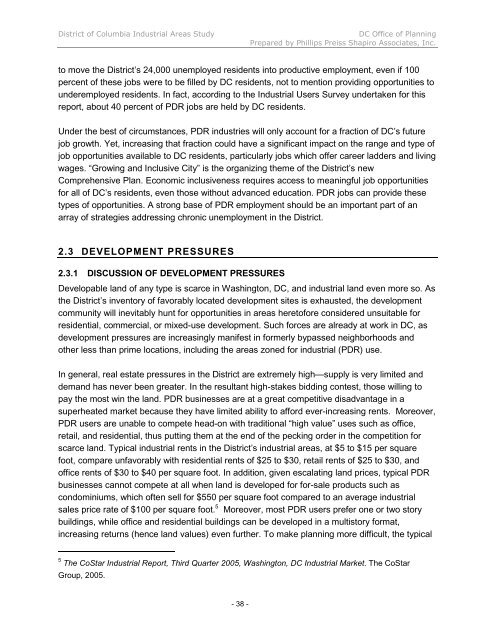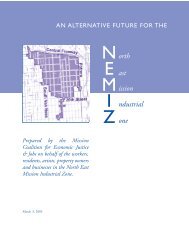INDUSTRIAL LAND IN A POST-INDUSTRIAL CITY District of ...
INDUSTRIAL LAND IN A POST-INDUSTRIAL CITY District of ...
INDUSTRIAL LAND IN A POST-INDUSTRIAL CITY District of ...
You also want an ePaper? Increase the reach of your titles
YUMPU automatically turns print PDFs into web optimized ePapers that Google loves.
<strong>District</strong> <strong>of</strong> Columbia Industrial Areas Study DC Office <strong>of</strong> Planning<br />
Prepared by Phillips Preiss Shapiro Associates, Inc.<br />
to move the <strong>District</strong>’s 24,000 unemployed residents into productive employment, even if 100<br />
percent <strong>of</strong> these jobs were to be filled by DC residents, not to mention providing opportunities to<br />
underemployed residents. In fact, according to the Industrial Users Survey undertaken for this<br />
report, about 40 percent <strong>of</strong> PDR jobs are held by DC residents.<br />
Under the best <strong>of</strong> circumstances, PDR industries will only account for a fraction <strong>of</strong> DC’s future<br />
job growth. Yet, increasing that fraction could have a significant impact on the range and type <strong>of</strong><br />
job opportunities available to DC residents, particularly jobs which <strong>of</strong>fer career ladders and living<br />
wages. “Growing and Inclusive City” is the organizing theme <strong>of</strong> the <strong>District</strong>’s new<br />
Comprehensive Plan. Economic inclusiveness requires access to meaningful job opportunities<br />
for all <strong>of</strong> DC’s residents, even those without advanced education. PDR jobs can provide these<br />
types <strong>of</strong> opportunities. A strong base <strong>of</strong> PDR employment should be an important part <strong>of</strong> an<br />
array <strong>of</strong> strategies addressing chronic unemployment in the <strong>District</strong>.<br />
2.3 DEVELOPMENT PRESSURES<br />
2.3.1 DISCUSSION OF DEVELOPMENT PRESSURES<br />
Developable land <strong>of</strong> any type is scarce in Washington, DC, and industrial land even more so. As<br />
the <strong>District</strong>’s inventory <strong>of</strong> favorably located development sites is exhausted, the development<br />
community will inevitably hunt for opportunities in areas heret<strong>of</strong>ore considered unsuitable for<br />
residential, commercial, or mixed-use development. Such forces are already at work in DC, as<br />
development pressures are increasingly manifest in formerly bypassed neighborhoods and<br />
other less than prime locations, including the areas zoned for industrial (PDR) use.<br />
In general, real estate pressures in the <strong>District</strong> are extremely high—supply is very limited and<br />
demand has never been greater. In the resultant high-stakes bidding contest, those willing to<br />
pay the most win the land. PDR businesses are at a great competitive disadvantage in a<br />
superheated market because they have limited ability to afford ever-increasing rents. Moreover,<br />
PDR users are unable to compete head-on with traditional “high value” uses such as <strong>of</strong>fice,<br />
retail, and residential, thus putting them at the end <strong>of</strong> the pecking order in the competition for<br />
scarce land. Typical industrial rents in the <strong>District</strong>’s industrial areas, at $5 to $15 per square<br />
foot, compare unfavorably with residential rents <strong>of</strong> $25 to $30, retail rents <strong>of</strong> $25 to $30, and<br />
<strong>of</strong>fice rents <strong>of</strong> $30 to $40 per square foot. In addition, given escalating land prices, typical PDR<br />
businesses cannot compete at all when land is developed for for-sale products such as<br />
condominiums, which <strong>of</strong>ten sell for $550 per square foot compared to an average industrial<br />
sales price rate <strong>of</strong> $100 per square foot. 5 Moreover, most PDR users prefer one or two story<br />
buildings, while <strong>of</strong>fice and residential buildings can be developed in a multistory format,<br />
increasing returns (hence land values) even further. To make planning more difficult, the typical<br />
5 The CoStar Industrial Report, Third Quarter 2005, Washington, DC Industrial Market. The CoStar<br />
Group, 2005.<br />
- 38 -












